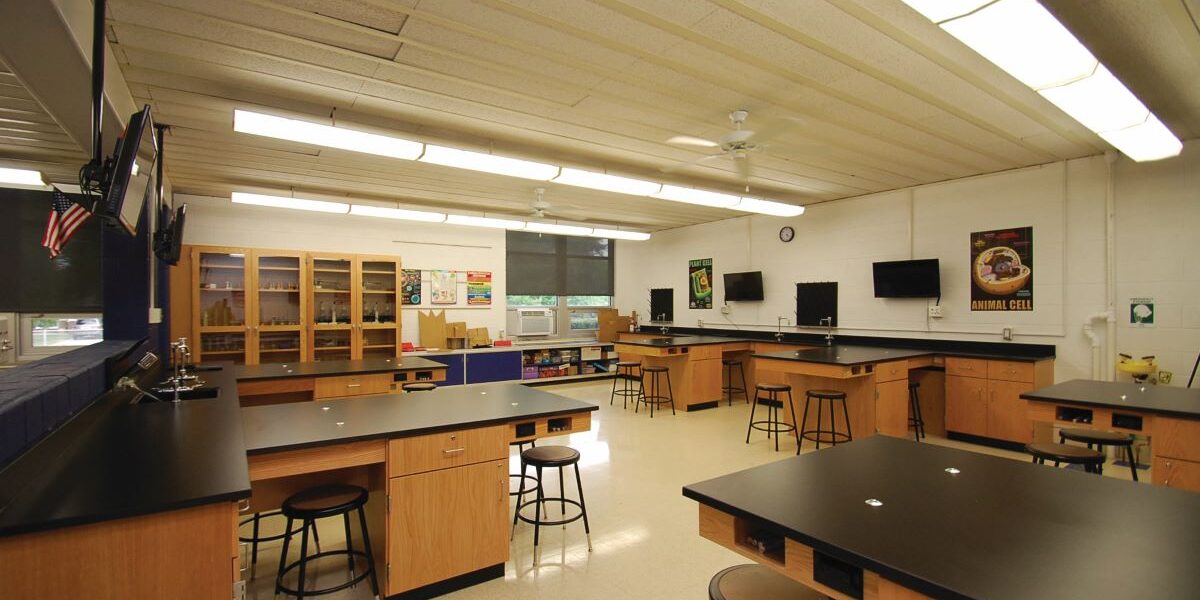Creating a Learning Space that Inspires
By Gigi Devanney, M.A.
There may be no other subject that demands more of the facilities in which it is taught than science. Whether you are teaching advanced biology, anatomy & physiology, introductory chemistry. AP physics or earth and environmental science, having access to an appropriate space can be critical to meeting instructional outcomes. Designing a science learning environment that is functional and durable and meets the needs of your students and teachers can be a daunting task.
Regardless of whether you are updating a current science lab, repurposing existing classrooms or designing a new build, your goal is to create a science learning environment that is both efficient and effective, as well as flexible enough to meet the changing needs of students and teachers.
There are many factors to consider, such as space, student capacity, the subjects to be taught, flexibility required, materials, technology, and budget. In this article, we will explore the best of school science lab design, and the considerations needed for designs and furniture that will last.
Space Considerations
The first step in designing a science lab is to consider the available space you have to work with. Not only will this determine the actual size of the lab and the number of students that can be accommodated, it will also guide many of your other decisions.
If you are starting from scratch with a new build, you may have the opportunity to design the space to your exact specifications. If you are repurposing or updating an existing room, you will need to work with the existing space and make adjustments as needed.
Your planning discussions should include the maximum number of students per class and space available (the National Science Teachers Association recommends 50 square feet per student, although you may have other factors to consider), the subject areas that will be taught in the space, and how the space will be used (for a lab only or a combination of lab and classroom.) (Note: science labs should be used only for science, no other subjects should be taught in the room.) Also consider the number of teachers that may share the space, if they will each need their own workspace, and if a designated area for teacher prep work is necessary.
Regarding science disciplines that will be taught in the space, note that chemistry labs require more safety elements than physics labs due to the chemicals used. (fume hood, eye wash stations, etc.) Make sure that your space design includes all the appropriate safety apparatus.
Lab, Classroom or Both?
Once you have determined the available space, the next step is to decide on the number and type of stations that will be used and how they will be laid out. Will the stations be fixed or movable? Will students be working individually, in pairs, small groups, or in large groups? How many stations will this require?
Will your lab space be just a laboratory or will it serve as a classroom as well? Designing a space that easily accommodates both lab benches and desks (or tables and chairs) may be the solution. If the lab is used primarily for experiments, the design should reflect this, with ample bench space and equipment storage. If the lab is also used as a classroom, the design should include tables and chairs for lectures and discussions.
Fixed lab stations are ideal for activities that require specialized precision equipment or tools, such as in chemistry, while movable tables are generally more versatile and can be used for a variety of subjects. Movable tables are also useful for creating collaborative workspaces, allowing students to easily work together in small groups, but they do have a tendency to be jostled which can lead to major shifting of material on the table top. Before making this decision, review the disciplines that will use this space and the activities that will be done at each station.
Another conversation with teachers should be around the storage space required. Glassware, apparatus, chemicals, and other classroom supplies take up lots of space. Chemicals, especially, should be stored in a secure location in cabinets designed to store the chemicals’ specific hazard.
Materials
The materials used in the lab are also an important consideration, especially work surfaces. Work surfaces can be made from a variety of materials and with a range of capabilities and prices – from the budget-friendly laminate to the durable, but more expensive, solid substance tops like epoxy resin and phenolic resin. Each material has advantages and disadvantages, so it is important to choose the right one for your needs.
Laminate is the most common work surface material and is relatively inexpensive. It is also easy to clean and is lightweight. It is not, however, as durable as other materials and may chip, crack, and delaminate over time and is especially susceptible to damage from heat. The edge banding is an especially vulnerable area. If this is your choice initially, you should understand that replacement may be needed a few years down the road.
Solid substance work surfaces do not have a wooden core but are solid through and through. Epoxy Resin and Phenolic are the most popular solid substance materials used in science labs. Both are non-porous and very resistant to chemicals. Both can be cleaned easily and offer good heat resistance. Phenolic resin will blister if exposed to focused, intense heat sources while epoxy will not. Although epoxy and phenolic are more expensive options they will still be usable 50 or more years after the date of purchase.
If your lab is primarily going to be used for physics, STEM or STEAM classes, then butcherblock is another option to consider. While not appropriate for use around chemicals of chemistry or biology activities, it is a great option for classes that will be doing more pounding, which could chip or crack the other top options.
Seating considerations are also important. Students will be spending a significant amount of time in the lab, so it is important to determine if seating will be used in the lab space. If the decision is to provide seating in the lab space then it should be comfortable and ergonomic. Stools in the lab area should be adjustable and provide adequate back support. Avoid seating that has fabric or vinyl coverings as those materials can absorb vapors and liquids. ADA considerations should also be taken into account to ensure that the lab is accessible to all students.
Instructional Technology
In today’s digital age, technology is an essential component of any instructional environment. Consider how you will incorporate projectors and screens, white boards or whiteboard paint. And also think about how computers, tablets, monitors and other devices will be used to enhance the learning experience. It is important to design a space that streamlines the use of required technology while protecting it from exposure to chemicals and liquids. Will you have a dedicated location for charging devices? High speed WIFI is essential for students to access online resources and collaborate with other students and teachers. Technology advances rapidly so try to build for the technology of tomorrow, not today.
While these are only a few of the topics to consider as you begin your lab design, your best resources are your science teachers who can give valuable feedback. And remember, whatever your space or budget restrictions, whether you are creating a new space or renovating an existing lab, you can create a learning environment that is sure to engage and inspire the next generation of scientists.
Gigi Devanney is the content marketing manager for Flinn Scientific, Inc. For almost 50 years, Flinn Scientific has been a trusted partner of science education professionals, and the best source for quality laboratory supplies, instructional tools and resources, and essential safety instruction, www.flinnsci.com.












